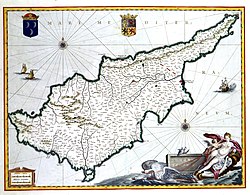| History of Cyprus |
|---|
 |
This is a list of wars involving the Republic of Cyprus and its predecessor states.
- Victory of Cyprus (and allies)
- Defeat of Cyprus (and allies)
- Another result*
*e.g. result unknown or indecisive/inconclusive, result of internal conflict inside Cyprus, status quo ante bellum , or a treaty or peace without a clear result.
| Conflict | Combatant 1 | Combatant 2 | Results |
|---|---|---|---|
| Greco-Persian Wars | Greek city-states : [iv] • Athens • Sparta • Thebes • Thespiae • Cyprus • Delian League | Achaemenid Empire Greek vassals: • Halicarnassus • Thessalia • Boeotia • Thebes • Macedon | Greek victory [1] |
| Kitos War | Roman victory [2]
| ||
| Fifth Crusade (1217–1221) | Crusaders: Levant: Military orders: | Muslim forces: | Ayyubid victory
|
| War of the Lombards (1228–1243) | . Kingdom of Cyprus | Holy Roman Empire
| Victory of anti-Imperial faction of local barons |
| Lord Edward's crusade (1271–1272) | Inconclusive
| ||
| Smyrniote crusades (1343–1351) | | Inconclusive | |
| Alexandrian Crusade (9–12 October 1365) | Crusader victory | ||
| Cyprus Emergency (1955–1959) | London and Zürich Agreements
| ||
| Cyprus crisis of 1963–64 | | |
|
| Cyprus crisis of 1967 | | |
|
| Turkish invasion of Cyprus (1974) | Turkish victory [7] [8] [9] [10]
| ||